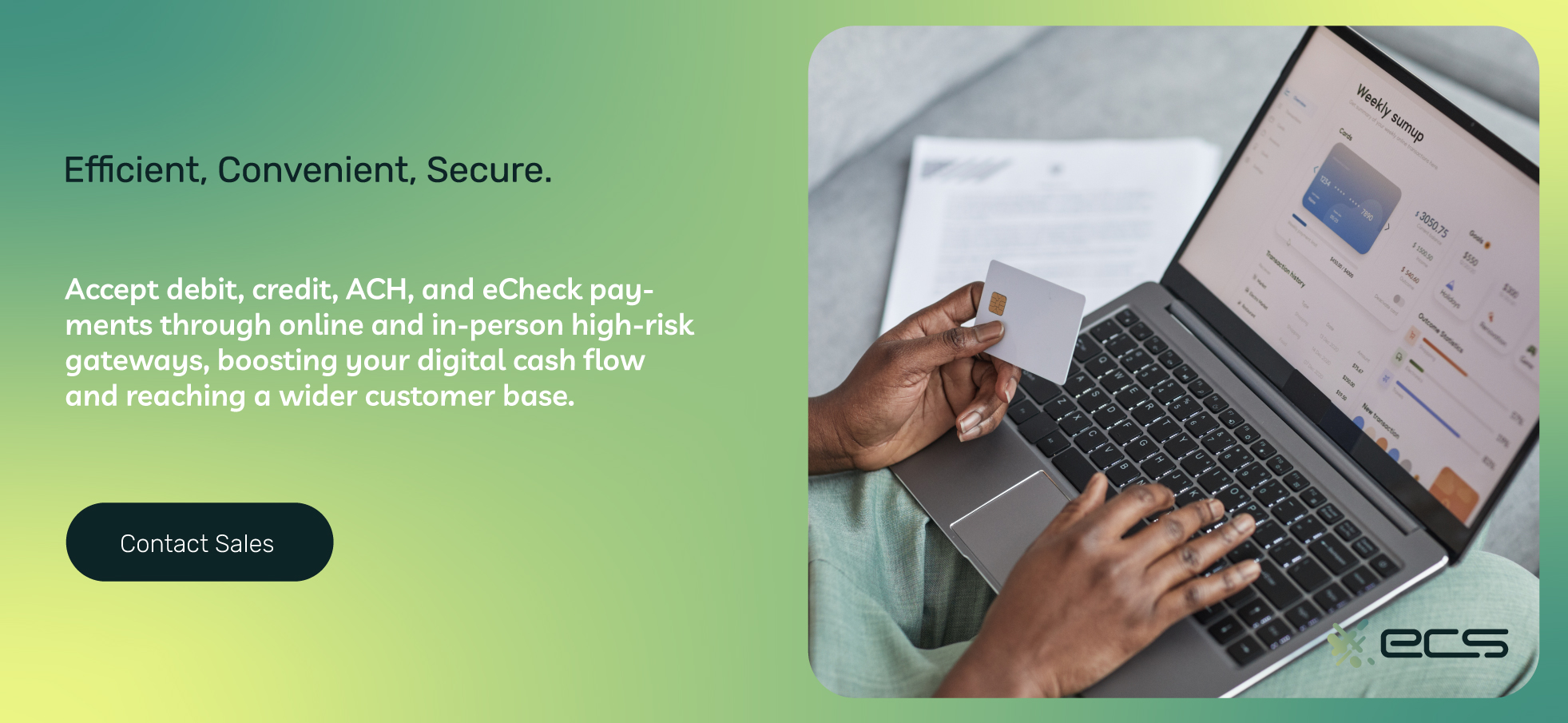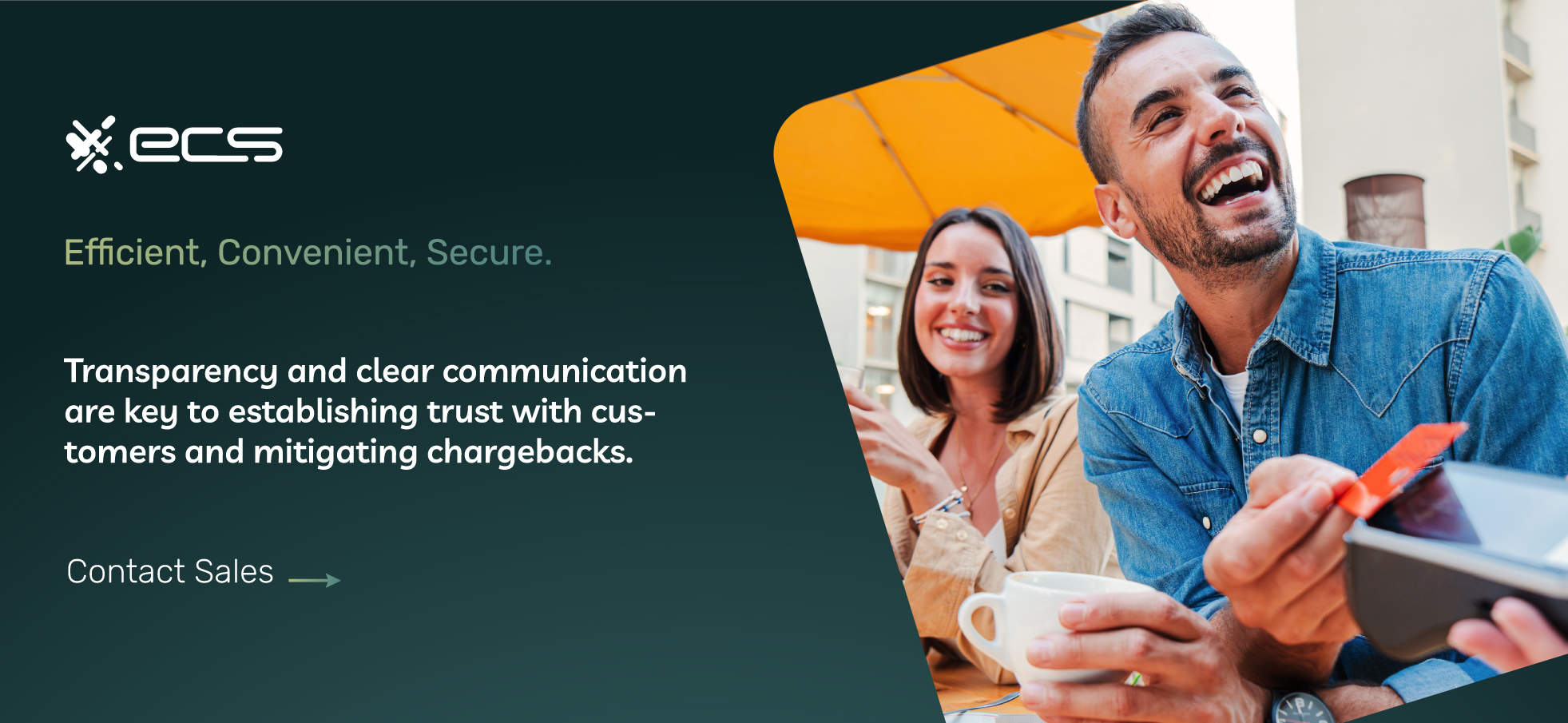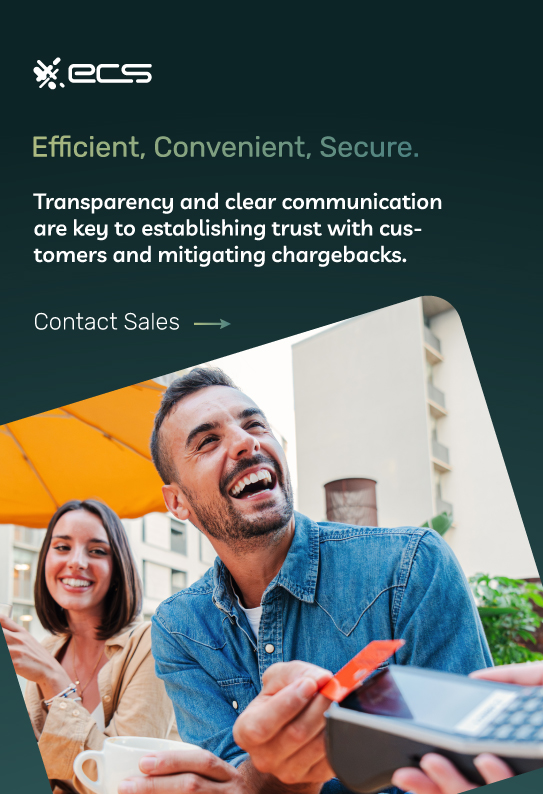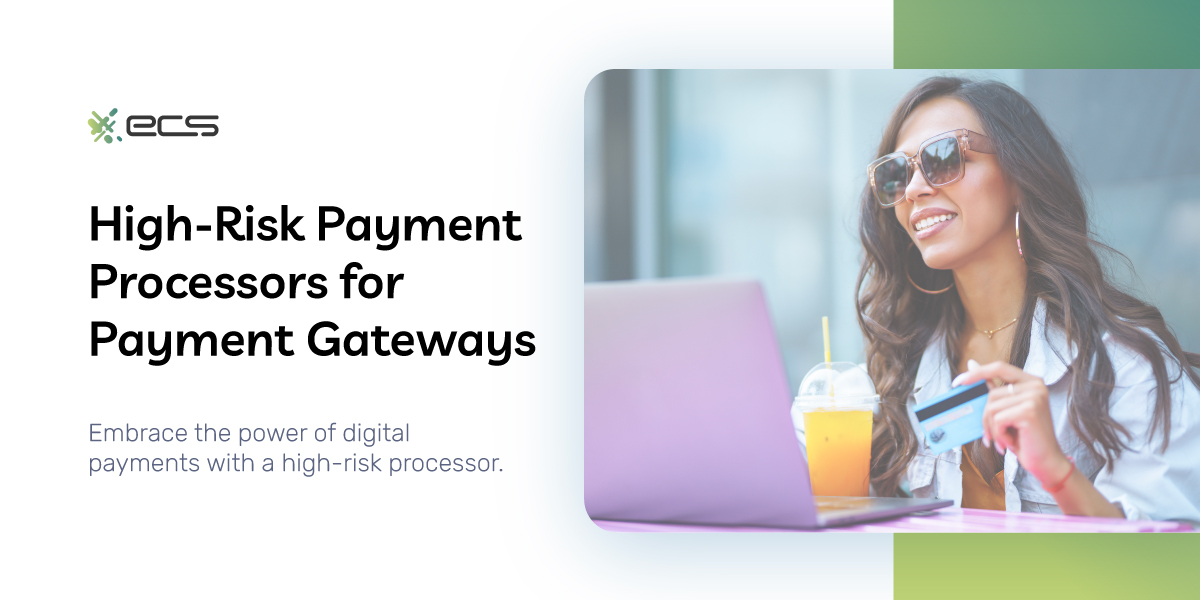A high-risk payment gateway is a payment gateway solution for businesses that present a high degree of risk for payment processing companies—either because they have a higher than usual percentage of chargebacks, there is a higher risk of fraud or a few other reasons that will be outlined below.
In some cases, payment gateways for high-risk businesses will have higher fees to compensate for the extra risk that the payment processor is shouldering. But of course, in today’s nearly cashless society, that beats the cost of not having a payment gateway at all.
What Is a Payment Gateway and How Does It Work?
To understand a payment gateway for a high-risk payments, it would be helpful to discuss payment gateway solutions in general. A payment gateway allows you to accept credit card payments, debit card payments, or mobile payments. The payment processor is the company that manages and services the gateway. The acquirer is the financial institution that services your merchant checking account. And you, the merchant, are the party that collects payment from your customer.
The first step in this process is that the cardholder makes a purchase by way of a point-of-sale terminal or your website. The payment gateway pushes the transaction information to the acquirer, determining which credit card network services the card: Visa, Mastercard, American Express, or Discover. The transaction is then routed to the appropriate payment switch, which routes a request to the issuing bank—the financial institution that issued the plastic and its associated account.
The issuing bank performs its fraud protocols to determine if the transaction is legitimate (for instance, within a certain radius of your address or within a certain reasonable amount), as well as establishing that your customer has enough credit or cash in their account to cover the purchase.
If everything checks out, the issuing bank sends its approval back through the credit card network to the payment gateway and the acquiring bank. In some cases, the merchant will need to reconcile payment by adding in tips, and then send a batch capture or clearing file for all the authorized transactions.

The Chargeback Chain Reaction and its Costs
As you can see from the above transaction description, there are several points along the way at which things could turn sour, even if your business isn’t selling lemonade. The result is a chain reaction with a lot of fees. If a customer or client goes over your head instead of requesting a refund and asks their bank to dispute the charge, that will result in a chargeback.
Chargebacks often cost a merchant between $20 and $100 each, depending on the various agreements in place. And that’s just from the acquiring bank! The payment processor may charge fees as well. In fact, they probably will—and both parties will charge more fees the more often it happens.
While there are different ways of computing the chargeback rate or ratio, generally speaking, you do not want it to surpass 1% of your transaction volume and don’t want it to surpass 100 per month. With stats like these, even a healthy business (from a chargeback perspective) could lose as much as $10,000 per month to chargebacks. If that potential number surprises you, consider the fact that chargebacks are costing businesses as much as $30 billion annually, which is more than the revenue of most Fortune 500 companies.
The truth of the matter is that chargebacks aren’t just expensive as a punitive deterrent. They’re expensive because the banks, networks, and payment processors involved in the transaction need to invest time, money, and effort in rectifying the transaction. The fees they charge help them cover their costs.
Although a merchant might pay an average of $128 per chargeback, $26 of this will help the acquirer cover their costs (on average), while $37 will help the issuing bank cover theirs. Chargebacks also cost banks billions of dollars every year. In fact, an estimate from Mastercard suggests that chargebacks in 2023 could accelerate to a global tune of $117 billion.
How Are High-Risk Payment Gateway Solutions Different?
From a high-level overview, there is not much separating the process of a high-risk business payment gateway from a standard or low-risk payment gateway. The same parties are still involved, with mostly similar processes.
However, high-risk payment gateway providers are often more adept at processing larger transaction volumes. They may have additional safety protocols in place for fraud detection. A few of the advanced screening tools they may leverage could include browser fingerprinting, IP blocking, historical card database checks, and email matching. They may also be more adept at facilitating international transactions. As you can see, many of the safety protocols require some proactivity in the form of screening payments, but that may be automated.
Some high risk payment gateways will require businesses to provide something called a rolling reserve, which is something like 5-10% (but sometimes up to 20%) of the cash value of their typical monthly transactions during a given period, usually 12-18 months.
The high risk payment processor will request to hold on to this rolling reserve for a certain period of time to cover any potential chargebacks. But as the name rolling reserve indicates, the reserve will need to be periodically replenished with new funds as new sales come in (so essentially cash is always rolling in and out of the reserve). The reserve is typically a non-interest-bearing account because its only purpose is to provide a safeguard for the financial institutions that are involved in high risk payments.
How Industry, Customer, and Business Dictate Risk
Another significant difference between a high-risk merchant payment gateway and a low-risk payment gateway solution is the business, the industry, and the typical customer involved in the transaction. If your business is brand new with no established history of processing payments, it will likely need a payment gateway for high risk merchants.
The same is true if it surpasses a desirable chargeback ratio (which again, according to most parties, is 1% and/or more than 100 chargebacks). If your business or its owners (you, for instance) have bad credit, you may also need high-risk merchant payment gateway solutions.
Sometimes it’s just the customer and the nature of your business. If you provide credit counseling, your customer base has an established history of not paying bills on time…or not paying them at all, ever.
If you sell guns, sprinkled in among your honest 2A-loving customers will be a potential criminal. If you facilitate sports betting or gambling of any kind, you are undoubtedly going to have some payments that are fraudulent or involve identity theft. Not to mention some that get contested because the person who lost their money is addicted to gambling.
The list goes on, but one common factor is that high-risk businesses are often subjected to fraudulent purchases, which frequently come back to haunt your business in the form of a chargeback.
But not every business requiring a high-risk merchant account payment gateway and high risk merchant processor involves guns, gambling, tobacco, marijuana, or adult entertainment. Other industries presenting a significant degree of risk to transactional parties include those with big-ticket items such as furniture, electronics, jewelry, and (drumroll please) tickets…to sporting events and concerts.
Other potential risk factors include traffic volume and international payments. Whatever the case may be, you need a high-risk merchant account payment gateway and high risk merchant processor to collect and process digital payments. With that said, let’s take a look at some of the options.


What About WooCommerce Stores and Other Online Store Platforms?
WooCommerce is WordPress’s platform to turn a general website into a fully functioning eCommerce store. As popular as the WooCommerce platform is, there are, however, restrictions on what can be sold via Woocommerce’s payment integrations and hosting services. Most restrictions pertain to sales related to anything in the high risk industry, such as CBD, firearms, nutraceuticals, etc.
Though WordPress has said it will continue to monitor the situation and perhaps make changes to its policy in the future, as of now, if you have a website through WordPress and want to use the WooCommerce plugin, you might have to find alternative solutions around this small dilemma.
But, so you know, all hope is not lost. This is where integrating with the right high risk payment processor who can offer the best high risk gateway for your eCommerce store comes into play with hosting outside of WooCommerce.
Let’s Clarify:
You can still absolutely use WooCommerce for your online high-risk website and store. The restrictions lie with the version of WooCommerce you must use, your hosting service, and your payment provider specifically.
With that said, WooCommerce can still be a viable option for those looking to enter the high-risk online market. Or for those merchants who are already experienced with the WooCommerce platform and don’t have the capacity to learn an entirely new platform to develop their business.
What’s the Difference?
The difference is that a merchant would need to use the open-source version of WooCommerce. It would be hosted on a merchant’s own server or web hosting account. Once that is installed, the open-source version of Woocommerce will look and act identically to the hosted version that comes with WordPress.com hosted websites.
Yes, the beloved features that retailers use with WooCommerce are all present in the self-hosted open-source version. So, there is really no difference when it comes to building, designing, and customizing your store to your liking.
The one big difference is the need to find an actual credit card payment processor that can integrate their high-risk payment gateway for your WooCommerce site. They will be the financial entity that will fund your credit card processing merchant account.
WooCommerce Hosting
When choosing the best host for your website build, you will want to be sure it can handle the type of website you have in mind. What do we mean by handle? We mean it must have the appropriate data usage capabilities and bandwidth that will allow for a smooth operation within the site.
Next, you’ll need to decide between an unmanaged server and a managed server. An unmanaged server allows for owner freedom. Basically, the owner of the site has to be able to maintain the installed software on the site.
This is a great option for advanced users, offering more flexibility and customization capabilities. However, for users who are not as experienced with website hosting, a managed account will generally be the best option.
A managed server is maintained by the site hosting company. All software is preinstalled and any request for changes typically needs to be done through the host’s support department.
Credit Card Processing Merchant Account
Once you have established your website host and are ready for the right high-risk payment gateway, you will need to be sure you have the right credit card processing merchant account for your needs with seamless integration via the WooCommerce store.
A credit card processing merchant account is a business account that gives high risk merchants access to a high risk gateway to accept credit and debit cards online. Or in person, if that’s your business model.
Payment processors, such as ecspayments.com, for example, specialize in high-risk transaction processing. And high risk payment processors make it simple to obtain a high-risk merchant account. So, let’s take a closer look at some of these high risk payment processors and their gateways.
Most Common High-Risk Payment Gateways
So, whether you use WooCommerce for high-risk payment or another website builder, you will need to research which payment gateway will be most beneficial for your needs. Let’s take a closer look at the most common high-risk payment gateway providers.
PaymentCloud
One option is PaymentCloud, which facilitates credit and debit payments, ACH, and eChecks for high risk merchants. A few of the industries it works with are guns, credit repair, online dating, and jet charters. Transaction fees can go as low as 2.90% + $0.30 per transaction but up to 6.50% for a keyed-in rate. Moreover, there is a $25 monthly payment gateway fee in addition to the per-transaction fees.
Host Merchant Services
Another high risk payment processor is Host Merchant Services, which facilitates credit cards in addition to mobile wallet payments (like Apple and Android). Host works with debt collectors, life coaches, pawn shops, and offshore businesses, among other industries. There is no monthly account fee and it is reputed to have great customer service. However, the payment structure for their high risk merchant services may present significantly high fees for new or smaller businesses.
Durango Merchant Services
Durango Merchant Services works with a number of high risk industries, including bail bonds, gaming, and fortune-telling. It specifically facilitates ACH and eCheck transactions for high risk merchants. It is also an international payment gateway for high risk businesses as it can process international currency payments. For businesses that need hardware, Durango does not lease terminals but sells them outright for anywhere between $170 and $400. Unfortunately, Durango is not transparent about its fees online, and high risk merchants need to reach out for a case-by-case discussion of fees and pricing.
SMB Global
SMB Global payment gateways provide credit card processing and ACH for high risk merchants. Travel, furniture, e-cigarettes, and herbal supplements are a few of the high risk industries it works with. Some businesses with mobile storefronts provide complimentary e-readers, but unfortunately, it does not offer that to every business. SMB Global is also not transparent about its pricing structure or which apps its software integrates with.
Soar Payments
Yet another option for high risk payment processors is Soar Payments. Antiques, bus lines, country clubs, pet products, and sports betting are a few of the industries it services. However, some high risk industries are even too risky for Soar, including crypto, debt collection, gambling, payday loans, marijuana, and kratom. Soar will also not work with businesses that have a bad credit rating. As you can imagine, this won’t work for every business.

ECS Payments
Sometimes it is best to work with a high risk gateway that has more flexible policies rather than one with a monolithic payment mode. Electronic Cash Systems or ECS Payments gives itself the ability to work with a diverse range of businesses including those in the high risk industries and caters to their needs in a more nuanced manner.
ECS offers payment gateways for high risk businesses for online payment processing and in person processing with countertop terminals, mobile terminals, and virtual terminal gateways. It facilitates credit, debit, and ACH transactions. Additionally, ECS offers mobile applications, recurring payment options, quick email receipts for customers, and automated end-of-day transaction reports, in addition to other features.
As you can see from the list of high-risk payment gateways above, some companies only work with specific types of businesses. In comparison, ECS Payments works with a wide range of verticals – low and high-risk.
Some low-risk industries ECS works with include:
- Automotive
- Grocery
- Local government
- Healthcare
- Hospitality
- Non-profit
- Personal care
- Retail
- Restaurant
- Etc…
Whereas ECS’s high risk industries may include:
- Adult entertainment
- CBD
- Credit Repair
- Debt consolidation
- Firearms
- Health supplements & nutraceuticals
- Licensed gambling
- Tobacco
- and more!
Moreover, ECS has other business solutions that could round out your payment solutions suite, such as ATM and banking services and even business loans and consumer financing options.
Does My Business Need a High-Risk Payment Gateway?
If your business has bad credit or you do personally, the answer is probably yes. If you sell big-ticket items, the answer is probably yes. If your chargeback ratio is above 1%, the answer is probably yes. And if your business is brand new, with no history of processing payments, the answer is probably yes. Lastly, if your business is an industry associated with risky products or one that creates potential legal consequences, you will probably need a high-risk credit card processor to service your needs.

Wrap Up
As discussed, the behind-the-scenes of a high-risk payment processor are not so different from that of a low-risk payment processor. There may be, however, additional safety protocols such as browser fingerprinting, IP blocking, historical card database checks, and email matching.
The payment processor itself may require you to keep a rolling reserve on hand to cover chargebacks. And structurally, they may be more adept at handling large transaction volumes or international payments. Whatever the particular needs of your business are, high-risk payment gateways online and for in-person transactions make it possible for your business to have a digital cash flow by collecting debit, credit, ACH, and eCheck payments.
To contact sales, click HERE. And to learn more about ECS High-Risk Payment Gateways visit High-Risk.
